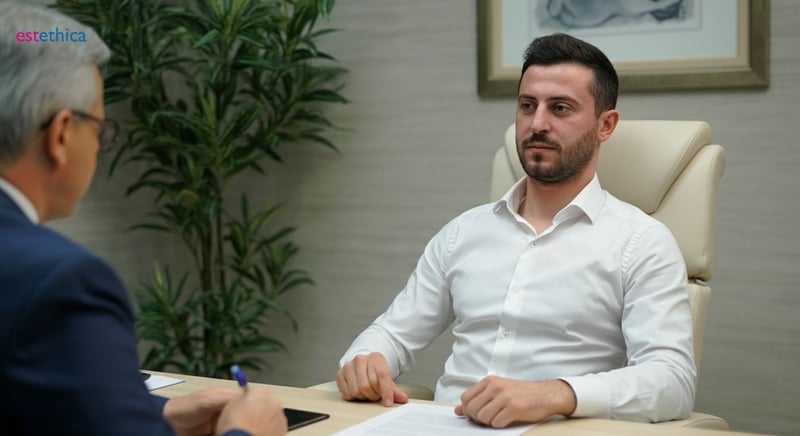Conquer Gynecomastia: Effective Surgery Insights
Discover effective solutions for gynecomastia at estethica, where quality meets professionalism.
Gynecomastia, characterized by enlarged male breasts due to hormonal imbalances, can significantly affect a man’s self-esteem and physical comfort. Understanding the causes and available treatments, including surgery, becomes vital. This guide delves into these aspects, exploring non-surgical options, assisting in selecting the best surgeon, and provides recovery insights post-surgery at estethica, known for its accredited healthcare services and award-winning aesthetic treatments.
Understanding the Causes of Gynecomastia
Hormonal Imbalance and Its Impact
Gynecomastia, characterized by enlarged male breasts, often stems from a hormonal imbalance between estrogen and testosterone. This imbalance can be triggered by various factors, including obesity, which increases estrogen levels, or hyperthyroidism, which affects hormone production. Additionally, certain medications, such as anti-androgens and anabolic steroids, can exacerbate this condition. Genetics also play a significant role, making it essential for individuals to seek expert diagnosis at specialized facilities like estethica. Understanding these causes is crucial for determining the most effective gynecomastia treatment.
Factors Contributing to Hormonal Imbalance
- Obesity: Increases estrogen levels, leading to hormonal imbalance.
- Medications: Anti-androgens and steroids can affect hormone levels.
- Genetics: Family history can predispose individuals to gynecomastia.
These factors highlight the complexity of gynecomastia and the need for personalized treatment approaches. By addressing the root causes, individuals can explore options such as male breast reduction or gynecomastia surgery to achieve desired outcomes.
Steps to Address Gynecomastia
- Consultation: Seek expert diagnosis to understand the underlying causes.
- Treatment Plan: Develop a personalized approach, considering non-surgical options.
- Follow-up: Regular monitoring to ensure effective management and prevention of recurrence.
By following these steps, individuals can effectively manage gynecomastia and improve their quality of life. Understanding the causes and available treatments is the first step towards achieving a balanced hormonal state and reducing the appearance of enlarged male breasts.

Exploring Non-Surgical Reduction Options
Natural Approaches to Gynecomastia Reduction
For those seeking alternatives to gynecomastia surgery, natural methods can offer viable solutions. Lifestyle changes, such as regular exercise and a balanced diet, can significantly impact male chest fat reduction. For instance, incorporating strength training exercises that target the chest area can help tone muscles and reduce the appearance of enlarged male breasts. Additionally, maintaining a healthy weight through a nutritious diet can prevent obesity-related hormonal imbalances, which often contribute to gynecomastia.
Hormonal Treatments and Their Role
In cases where hormonal imbalance in men is a primary cause, professional guidance on hormonal treatments can be beneficial. These treatments aim to rebalance estrogen and testosterone levels, potentially reducing the need for gynecomastia removal through surgery. It's crucial to consult with healthcare providers at specialized centers like estethica to determine the most appropriate treatment plan.
Key Lifestyle Modifications
- Regular Exercise: Focus on chest-targeted workouts to reduce male chest fat.
- Balanced Diet: Prevent obesity and related hormonal imbalances.
- Professional Consultation: Seek expert advice for tailored hormonal treatments.
These lifestyle modifications, combined with professional guidance, can offer effective non-surgical options for those dealing with gynecomastia. By addressing the root causes and making informed choices, individuals can achieve a more balanced physique without undergoing a gynecomastia operation.
Understanding the Process of Hormonal Treatment
- Diagnosis: Identify hormonal imbalances through medical evaluation.
- Treatment Plan: Develop a personalized approach with healthcare professionals.
- Monitoring: Regular follow-ups to assess treatment effectiveness and adjust as needed.
By following these steps, individuals can explore non-surgical gynecomastia options effectively. Understanding the process and potential benefits of hormonal treatments is essential for those seeking alternatives to surgical intervention.

Choosing the Best Gynecomastia Surgeon
Evaluating Surgeon Credentials and Experience
When considering gynecomastia surgery, selecting a qualified surgeon is crucial for achieving optimal results. At estethica, patients benefit from state-of-the-art technology and a team of specialized professionals. To ensure the best outcomes, it's important to evaluate a surgeon's credentials, including board certifications and years of experience in performing male breast reduction procedures. Additionally, reviewing past patient outcomes and testimonials can provide valuable insights into a surgeon's expertise and success rate.
Key Factors in Surgeon Selection
- Board Certification: Verify the surgeon's credentials and specialization in gynecomastia treatment.
- Experience: Consider the number of gynecomastia surgeries performed and their success rates.
- Patient Reviews: Analyze feedback from previous patients to gauge satisfaction and outcomes.
These factors are essential in choosing a surgeon who can effectively address issues like enlarged male breasts and hormonal imbalances in men. By prioritizing these criteria, patients can make informed decisions and enhance their chances of a successful gynecomastia operation.
Understanding the Surgical Process
- Consultation: Discuss goals and expectations with the surgeon to tailor the procedure.
- Preparation: Undergo necessary pre-operative assessments and follow guidelines for surgery readiness.
- Post-Operative Care: Follow the surgeon's instructions for recovery and monitor progress.
Understanding the surgical process is vital for those considering gynecomastia removal. By engaging with experienced professionals and adhering to recommended practices, patients can achieve desired results and improve their quality of life.

Navigating Post-Surgery Recovery
Essential Post-Operative Care Practices
Post-surgery recovery for gynecomastia patients involves crucial steps to ensure optimal healing and results. Wearing compression garments is highly recommended to minimize swelling and support the new chest contour. Patients should avoid physical exertion, including heavy lifting and intense workouts, for a specified period as advised by their surgeon. This helps prevent complications and promotes faster recovery.
Key Recovery Tips
- Compression Garments: Essential for reducing swelling and supporting the chest.
- Rest and Relaxation: Crucial to avoid physical exertion and promote healing.
- Follow-Up Appointments: Important for monitoring progress and addressing concerns.
These practices are vital for a smooth recovery process, ensuring that patients achieve the desired outcomes from their gynecomastia operation. Adhering to these guidelines can significantly enhance the healing experience.
Understanding the Recovery Timeline
- Immediate Post-Op: Focus on rest and wearing compression garments.
- First Few Weeks: Gradual return to light activities as advised by the surgeon.
- Long-Term Care: Regular follow-ups to ensure complete recovery and satisfaction.
Understanding the recovery timeline helps patients manage expectations and plan their post-surgery activities. By following these steps, individuals can ensure a successful recovery from gynecomastia removal, ultimately enhancing their quality of life.
Innovative Hormonal Imbalance Treatments for Gynecomastia
Comprehensive Post-Surgery Recovery for Optimal Results
Frequently Asked Questions
What are the main causes of gynecomastia?
How can gynecomastia be reduced naturally?
What should I consider when choosing a gynecomastia surgeon?
What is the recovery process like after gynecomastia surgery?
Discover the path to your healthiest and most beautiful self with estethica's award-winning services. Call now for a free consultation and let our expert team guide you on your journey to wellness and aesthetic excellence.
📞 Call for Your Free Consultation Today!